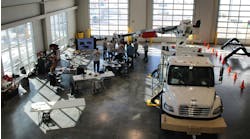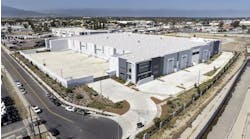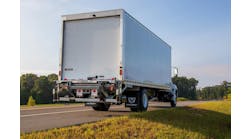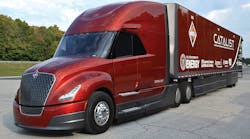The significant improvements in freight efficiency achieved with Navistar’s innovative SuperTruck demonstration vehicle, dubbed the CatalIST, demonstrate the potential for reduction in the trucking industry’s consumption of energy, and a number of the technology innovations achieved through the program are already being implemented in production vehicles today.
Jacques Gagne, International’s vocational sales manager for eastern Canada, broke down the program as part of the CTEA’s OEM Future Truck Panel, which also featured Garry Kellner of Kenworth Canada and Greg Grabinsky, Canadian vocational sales manager for Peterbilt.
The last three letters of CatalIST stand for International SuperTruck, referencing the vehicle’s International Trucks branding. The concept underscores the company’s conviction that the innovations achieved through the program will serve as the catalyst for significant improvements in future commercial vehicles.
It was part of a five-year project by the US Department of Energy (DOE), with the results announced in December 2016.
The rig achieved a freight-efficiency improvement of 104% compared to the MY2009 control vehicle, exceeding the improvement goal set by the DOE. In addition, the Navistar vehicle has achieved fuel efficiency of 13 miles per gallon, and demonstrated 50.3% Brake Thermal Efficiency (BTE) and a path towards 55% BTE.
Navistar’s predictive cruise control technology is an example of a significant technical innovation the company achieved through the program. Predictive cruise control looks ahead of the vehicle and recognizes the terrain and continuously calculates the most efficient speed and gear for optimal fuel economy in real time. The company’s system uses preinstalled GPS maps and the latest commercial route data to make adjustments to cruising speed without the need to pre-drive the route.
Other improvements included:
• Advanced integration of Navistar N13 Engine utilizing proprietary intelligent controls and high-efficiency combustion.
• Reduction in aerodynamic drag through replacement of cab- and hood-mounted mirrors with a series of cameras and interior-mounted monitors, which also yield equal or better indirect vision for the driver.
• A new LED headlamp system that reduces lamp size for a more aerodynamic shape and cuts electrical power requirements by greater than 80 percent, while improving luminous output and light color for improved night-time direct driver vision and reduced driver fatigue.
• An all-new shape with a sloped windshield and wedged cab for improved aerodynamics. Innovative use of lighter-weight carbon-fiber panels in the upper body, roof headers, back panel, and dash panel.
• A hybrid front suspension and lightweight rear suspension that leverages lightweight alloys with composite materials, reducing weight and enabling an electronic ride height management system, which provides dynamic ride height and pitch control for improved aerodynamics.
• Aerodynamic improvements that reduce the trailer’s drag coefficient by more than 30%.
Gagne also talked about the company’s strategic alliances with GM (building their cutaway van in Navistar’s Springfield, Ohio, assembly plant) and VW.
The alliance with VW is based on three components:
• Equity investment. Volkswagen Truck & Bus have taken a 16.6% equity stake in Navistar and received two seats on Navistar’s board of directors.
• Strategic technology and supply partnership. A technology and supply partnership between companies will enable collaboration in all aspects of commercial vehicle development, from powertrains to connected vehicle solutions, autonomous technologies, electric powertrain, cab and chassis components.
• Procurement joint venture. A procurement joint venture will source parts for both companies, providing them with greater global scale. This will enable Navistar to compete more effectively with other global truck manufacturers now operating in the US.
As announced at NACV in Atlanta in September, Navistar will work with VW to develop and launch an electric medium duty truck in 2019. Navistar will use the VW RIO System to integrate with On Command Connection to provide enhanced uptime for customers.
RIO was launched at the beginning of 2017, as an open cloud-based “operating system” for the entire transportation industry. Because it brings all relevant information together, such as tractor units and trailers with traffic, weather or navigation information, RIO delivers concrete recommendations for action in real time.
OnCommand Connection Currently supports more than 325,000 vehicles. A standard offering on International trucks, it’s a telematics and remote diagnostic tool that works on all makes and models equipped with a J1939 or J1708 port.
It’s focused on improving vehicle uptime, total cost of ownership, communications (internal and with dealers), and the overall process flow.
The Electronic Driver Log OnCommand Connection suite includes:
• Time management. Automatic auditing tells you how much time you have left.
• Universal. All makes. All models from 2000 and newer.
• Driver alerts. Alerts of upcoming violations.
• Set up in a snap. Simple interface that walks you through set up.
• Powerful back-office. Keep track of driver availability, logs, and DVIRs.
Giving product updates, he said the MV-HV interiors have been completely redesigned:
• Standard cluster. Incorporates all necessary driver communications into one location. Alerts, advanced braking, cruise control, transmission, TPMS, gauges.
• Premium cluster. Large LCD center display. Improves time spent with eyes on the road for safety. Easy to use. Eliminates the need for many hardwired gauges with new virtual gauges.
The updated design has a one-piece door frame. Removal of the vent window reduces wind noise and improves visibility. The speaker has been moved to front door panels.
There is a new column-mounted shifter for AMT and Allison 3000 and 4000. There is L-D-N-R, engine brake, and manual shifting in a single control. It’s available with non-park pawl transmission, and the location allows use with the hand on the wheel for safety.
Features of the new HV series:
• Huck bolt chassis fasteners provide superior clamping force and will not come loose even in extreme environments.
• Single 3.35M RBM 1/2“ x 11-1/4” frame rail has the strength of a double rail but lighter in weight and without the chance of inter-rail corrosion.
• Standard breakaway mirrors minimize cab and door damage.
• Double-sided galvanized steel cab with superior fit and finish and corrosion resistance.
• Option stainless-steel oil pan for reduced corrosion in highly corrosive applications.
• Integral 20” and 27” frame extensions (not bolt-on) for superior strength and reliability.
• Available battery in cab allows for more space on frame rails
Garry Kellner
Kenworth Canada
Kellner said results will be seen with autonomous trucks (highway and over-the-road), the SuperTruck program (fuel efficiency/GHG requirements, 2021, 2024,2027), truck platooning, new hybrid technology (battery improvements), and reducing engine parasitic loads (cooling fans).
“Future technology is good,” he said. “It’s all going to come to us at one point or another, and it will come to us in different forms, whether on highway or vocational. But your market is vocational trucks.”
He discussed Kenworth’s conventional medium-duty models. The T170 is a Class 5 model with a GVWR of 19.5K and hydraulic brakes. The T170 is lower than the other models and is spec’d with 19.5” wheels and a 7L PX-7 engine. The T270 is the non-CDL Class 6 model and can be spec’d with air or hydraulic brakes, automatic/manual/automated transmission, and optional 22.5” wheels. The T270 also adds the option of a PX-9 9L engine.
Specific options offered on medium-duty trucks:
• Short battery box under the cab.
“We realize that frame space is a premium as trucks are becoming more and more complicated,” he said. This is a great option for fire or emergency vehicles, utility bodies, or anyone needing a completely clear back of cab. We also have a matching tool box for the opposite side if needed.
• Between-rails fuel tanks.
“Just like the narrow battery box, this option was designed for emergency service vehicles or utility applications. The fuel tank itself is mounted between the rails behind the rear suspension and is available in a 45-gallon or 70-gallon size. It is compatible with both air ride or spring suspensions, and can be used with any exhaust combination.
• Custom frame layout.
“The customer or the body builder can specify exactly where they would like the fuel tanks, battery box, DEF tank, air tanks, and crossmembers placed. We will also work with you to place a factory-installed split shaft PTO, or we can set up our drivelines so that a split shaft PTO can be installed after the fact. This can save an enormous amount of time and money compared to relocating components after the truck is built.”
New medium-duty products:
• Heavy axles.
“The T370 is now available with front axles rated up to 20,000 pounds and rear axles available up to 46,000 pounds, perfectly suited for vocational applications. The heavy axle options are a perfect fit for a large range of baby Class 8 vocations such as construction, vac trucks, and heavy utility operations. These axles also make the T370 a very cost competitive option for the baby Class 8 market.”
• Collision mitigation on the T270 and T370.
“Bendix Wingman advanced is now available, and we are planning on launching Bendix Fusion. will also detect stationary objects and provide a warning to the driver.”
• Front axle ratings.
“In May, we will be launching two additional ratings for front-drive axles and a new transfer case. The front drive axles will be available in 18k and 20k, which will be launched with a new TC-548 transfer case, which will be a great fit for heavy off-road applications such as utility cranes.
• Primaax single rear axle suspenion.
“The Hendrickson Primaax combines the comfort of air suspension with the stability of a mechanical suspension. The Primaax is already available on our heavy-duty models as well as T370s with a front drive axle or with a tandem suspension. However, the Primaax will be a new offering for T370s with a single axle and without a front drive axle. This will be a great fit for refuse trucks or utility cranes that need stability, but are limited to a single axle.”
Greg Grabinsky
Canadian vocational sales manager for Peterbilt
“People are talking about autonomous vehicles. We like to look at it as autonomous, but also driver-assisted,” Grabinsky said. “How can we make that truck safe and a better working environment for the drivers?”
From of the SuperTruck program, Peterbilt was able to utilize the investments of PACCAR and the government to work on new developments.
Peterbilt’s SmartLINQ connected truck technology helps provide maximum uptime and ensure trucks are running at peak performance. The SmartLINQ remote diagnostics system is standard on all Peterbilt models.
SmartLINQ features:
• Instant, at-a-glance fleet health with detailed diagnostics and recommended actions.
• Convenient SmartLINQ app for both Android and iOS platforms.
• A web-based portal through PACCAR Solutions.
• Customizable, 24/7 notifications to make quick, informed service decisions.
• Monitors more than 750 engine and aftertreatment diagnostic codes.
• Complimentary two-year subscription (longer with applicable extended warranties).
• Track trucks throughout North America, with units color-coded to indicate health.
“Reasoning engine technology,” a collective knowledge approach to truck diagnostics and repair, is integrated with the SmartLINQ platform. SmartLINQ’s reasoning engine technology collects and analyzes information generated by the on-board diagnostics of every SmartLINQ-enabled truck.
He said Peterbilt’s advanced concepts research includes: autonomous assist driver systems; next-generation engines; advanced powertrains; idle reduction; alternative fuels; component electrification; alternative fuels; and HMI (human machine interface).
Advanced powertrain research includes: alternative fuels; hybrids; turbines; fuel cells; and 2-stroke diesels.
Technology demonstration studies have involved the Model 386 Aero 2 package, lightweight optimization, HD hybrid development, electrified AC condenser, Corvus energy demo, and 2012 and 2014 tech trucks.









